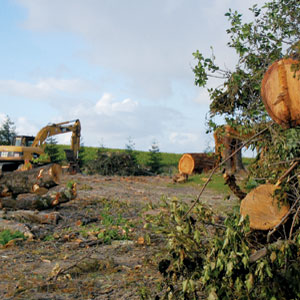Oenophiles who consume $230 magnums at Silicon Valley’s top restaurants may be unaware that one “rock star” winemaker currently finds himself in hot water.
This past October, in a rare instance of a local politician speaking out publicly against a member of the North Bay’s influential winemaking community, Sonoma County Supervisor Efren Carrillo lambasted winemaker Paul Hobbs for uprooting hundreds of trees in Sebastopol and adding one more open wound to a Russian River watershed already impacted by erosion and sediment. According to several Silicon Valley sommeliers, Paul Hobbs wines are among the most popular in the area’s top-tier restaurants.
Carrillo called Hobbs “one bad apple,” and noted that the globally renowned maker of high-end wines hadn’t bothered to acquire a permit to remove the trees, part of an old Christmas tree farm, which Hobbs is planning to buy and convert to vines.
It was one of three instances this year in which Hobbs has cut down trees to the dismay of onlookers. He leveled 10 acres in Pocket Canyon just east of Guerneville, and eight acres of redwood trees along Highway 116 on land acquired in a court settlement from his neighbor, John Jenkel.
“Paul Hobbs has shown a blatant disregard for Sonoma County, its resources, his fellow vintners and community sentiment,” Carrillo declared in an editorial printed in the Sonoma County Gazette.
All of this comes as a shock to Bert George, an industry expert of more than three decades and owner of one of San Jose’s most popular wine vendors, Joseph George Wine Shop.
“I would think clear-cutting happened back in the ‘50s, when people didn’t care. But people are so environmentally aware that I couldn’t imagine them doing anything like that,” George says. “We’ve sold Paul’s wines for probably 20 years. He’s not only a personal friend; he’s one of the best winemakers in the United States. He’s a rock star.
“If you’ve ever talked to Paul or met him, that’s not acceptable in the wine business. That just doesn’t go on.”
But environmentalists believe that Carrillo’s outburst over Hobbs’ actions needs to be echoed 100 times over. To Jim Doerksen, who has lived in the Mayacamas Mountains for 44 years and has watched local streams sucked dry as wineries near his property have been built, Carrillo’s words on Hobbs only amplify the silence that nearly all Sonoma County officials have kept toward the local wine industry through years of alleged environmental abuse.
“Efren said Hobbs is ‘one bad apple,’” Doerksen says, “but all we have are bad apples.”
Doerksen points straight to his neighbors, whom he charges with illegally cutting down about 60 acres of conifers to plant vineyards.
“These guys at Pride and Cornell [vineyards] are doing way worse things than Hobbs, but no one can see what they’re doing because they’re way up here in the mountains,” Doerksen explains. “Hobbs was right on Highway 116. Everyone saw the trees coming down. Efren had to say something.”
Carrillo tells Metro that Hobbs, who did not respond to requests for comment, showed defiance of law that mandated an objection. “My reaction was just my response to anyone not following policies that we have in place,” Carrillo says.
{pagebreak}
But do Silicon Valley wine connoisseurs really care? Josh Weeks, owner of the Michelin-starred Plumed Horse restaurant in Saratoga, which boasts one of the most impressive wine selections in all of California, says his patrons are more concerned with the experience of their meal and wine than pairing their appetites with activism.
“Even if a couple do know about [clear-cutting], it’s nothing that’s somebody asks about or mentions,” Weeks says. “I’m an experience-oriented restaurant. … I’m not saying that if [winemakers] are fertilizing with baby seals that customers would still be buying it, but it’s not really a big deal.”
Living Sponge
Conversion of forestland to vineyards is tremendously destructive, according to Chris Poehlmann, director of Friends of the Gualala River. The activity, he explains, is even more harmful to a forest than clear-cutting; planting a vineyard requires permanently or indefinitely eliminating the forest as well as the soil, precluding any foreseeable opportunity for second-growth trees.
The ecosystem from the treetops to the roots is annihilated as the stumps are bulldozed and the remaining forest detritus and topsoil scraped away, flattening the earth’s surface and readying it for vines.
“The forest is like a living sponge that slowly drains water collected during the winter into the streams and keeps fish alive,” Poehlmann says. “When you scalp these mountainsides and turn the mountain into a bald bowling ball, that effect is gone, and you have nothing but a biological desert.” Without the stabilizing effect of tree roots, rain water gushes down such uprooted slopes like rapids down a waterslide, and erosion can be severe.
But land-use and environmental lawyer Eric Koenigshofer, who is employed by the Preservation Ranch project, which, if approved, would clear 1,769 acres of second-growth redwood trees in the upper reaches of Sonoma County’s Gualala River for 1,100 acres of vineyards, says that careful management can amount to an overall benefit to local ecosystems.
Of the 300 miles of roads already extant on the Preservation Ranch site, the project proposes to put only 100 miles of them into use while reverting the other 200 miles into woodland, Koenigshofer says. Along the roads designated for use, the antiquated systems of ditches and culverts, which can exacerbate erosion, will be eliminated. The vineyards, he says, will be planted well within the slope-steepness limits defined by county grading laws.
While Preservation Ranch is 43 times bigger than the county’s largest-ever permitted timberland conversion on record—a 41-acre plot owned by Kendall-Jackson, approved for cutting in 1997— “it’s also the largest privately funded land-preservation project that has ever been put in place here,” Koenigshofer says.
Some environmentalists say that legal lenience toward the Sonoma County wine industry can be traced back to the 1970s, when the threat of suburban sprawl spilling off the Highway 101 corridor was staunched by amendments to county code. Those amendments gave agricultural lands legal precedence in the fight to survive. Today, that agricultural land has become mostly vineyard land.
But the outlook for forest conservationists could be improving in Sonoma County. The timber conversion ordinance of 2006 appears to have had an effect in slowing the crawl of vines into the county’s wooded hill country. From 1979 to 2006, 25 conversions of timberland to agriculture occurred, amounting to 21 acres per year. Thirteen of those projects occurred in the grape-crazy years from 2001 to 2006, but all legal timbering activity abruptly stopped with the new ordinance in place. No officials could estimate for Metro how common illegal timber removal is in Sonoma County.
Preservation Ranch is advancing along the lines of the law, but the fact that its size amounts to three times the area of all Sonoma County timberland ever converted into agriculture—573 acres—strikes dread in conservationists.
“In the old days, farming meant growing food or fiber, things to be eaten or things to be turned into clothing,” observes Stephen Fuller-Rowell, a co-founder of the Sonoma County Water Coalition. “Now, a main product of farming here is alcohol.”
Josh Koehn contributed to this report.

 Indoor Race Venue Offers Sense of Speed
Indoor Race Venue Offers Sense of Speed  Best Bites: San Jose Italian Restaurants
Best Bites: San Jose Italian Restaurants 

